WE ARE THE PROGENY OF THE BIG BANG I'm no comet, no constellation, just a telescope on our sky, observatory of meteors and moonly progress. I see we are not ourselves only but also parallels and echoes of the ones who came before. Not only our own singularities, but also we are in part products of our planet's climes, times, crimes. Properties of the universal particles. The passed is my present, given for your predictions, as light is the shadow of infinity's origin. SUNSHINE PACT Love did survive the midnights though when we swore each other our love would last forever we meant mainly in sunlight. But at last it was the fire that burned us into liars. SOME FOUR OR FIVE DESCENTS SINCE Natural selection's neutral in terms of progress and morals. Random goes unpredictable-- noble or reprehensible. Once, in effect, we had five hands-- two top, two down, and one behind. We lost our old prehensile tails-- the cost of opposable thumbs. We got better, sensible brains by trading touch for cranium. THAT ANCIENT GENTRIFICATION Your good neighborhood is rezoned. The lawns have given way to bones, mausoleums of expired hours, and dank granite-dungeoned towers. After your last mortgage was paid the real estate mortician made that inevitable deal: Trade your habit-practiced house of flesh for a dormitory of death. AMPHIBIANS Part of us is feather, another is anvil. As reptiles of reason and fishes of passion we are amphibians that define the betweens, a muddle of middles among brakes and throttles. And the trajectories of our biographies trace patterns of lurches and runs and reverses and rises and lunges and ripraps and wrenches and pauses and passes and misses and catches. Ah! Those rubs and doublings. CORRECT ATTRIBUTION The thrust, parry, and riposte are claimed by the saber, yet, the point, the edge, the hilt imply a duelist. As though there were no poet, the pen boasts the epic; and the hammer, the palace as though no architect. So do not infer agents are the inspiration.
Shelby Stephenson reviews Stephen E. Smith’s Beguiled by the Frailties of those Who Precede Us
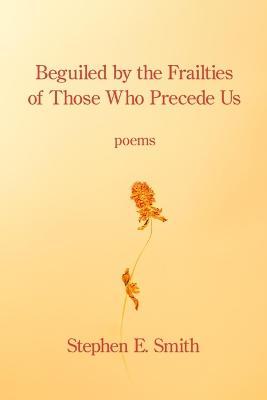
TRUTHS AS IMAGINED MEMORIES
Review by Shelby Stephenson of Beguiled by the Frailties of Those Who Precede Us written by Stephen E. Smith (Kelsay Books, 502 South 1040 East, A-119, American Fork, Utah 84003: Kelsaybooks.com)
These are poems, for one thing, about the “there” – there!
Beguiled by the Frailties of Those Who Precede Us: the title tells all, if it could, for Stephen E. Smith shares the joy of family, father and mother, a son, and graves popular as Mortality’s song that others will come along, even after “released on bond.”
What mortal words bring to knowing and not-knowing brim in these poems. See “Stepping Out of Poetry.” Stephen’s father was a boxer: the poem deals with many subjects, the main one, I think, racial prejudice: the conviction of Jack Johnson “by an all-white jury of violating the Mann Act—transporting a woman (in this case his wife) across state lines for immoral purposes—and he was sentenced to a year and a day in federal prison.” Stephen presents his father pondering Humanity. The color-line dominates, still does—in our lives and in American poetry.
Loiter and laugh as wakening comes again: “Last July” shows the natural Unnatural as a child cries as his father leaves him for a podium to read poetry to an audience, the child, now grown, moving us to the window-light.
I did that this morning: opened the blinds. The world said, Hello!!
This book does too, gives light–big time.
Stephen E Smith lives in Southern Pines, North Carolina. His reviews and essays are featured in PineStraw, Walter, and O. Henry Magazine. The book is available here from Kelsay Press.
Short story from Chris Butler
The Chase
A fall afternoon. On an empty road, surrounded on both sides by thick pines. Nothing above but gray clouds. Nothing below but gray concrete. There is no wind. No birds signing. No sounds at all, except the scraping of the bottom of a small child’s worn shoes against the concrete, and the click and clack of her mother’s high heels stepping from heel to toe. Heel to toe.
Both dressed in white, buttoned-down shirts, with short black skirts, cut just above the knee, the little girl and her mother walk down the road. She reaches up to grab her mother’s swinging hand, but can’t touch it. It is too high. Her little legs speed up. Her mother’s hand is swinging too fast for her outstretched little hand to grasp. She calls out, “Mom”. Her mother’s long legs stride longer and longer. Her little legs try to keep up. The little girl’s walk becomes a slow jog. She’s still extending her hand, still unable to reach. Her mother’s arm swings like a pendulum, with no signs of slowing. She jumps with her little legs, but still cannot reach. Her mother’s body begins to pull ahead of her daughter. She calls out for her mother again. “Mom.” The little girl’s slow jog speeds up. She jumps up, and down, up and down, reaching for her mother’s swinging hand. “Mom!” She calls again. The mother’s stride widens, the distance between them grows slowly, like the long, black strands of hair on the back of her mother’s head. The little girl cries out, “Mom!” But the mother does not turn around. She does not slow down. Her feet seem to be moving more quickly than before. “Mom!” The clicking of her heels, heel to toe, heel to toe, sound like a clock being winding forward, each second getting faster and faster. “MOM!” The little girl cries out for her mother to turn around. Her mother is too far ahead of her to reach with her short arms. And her clicking heels smack the pavement to a faster rhythm. Click clack. Heel to toe. The little girl’s jog accelerates into a slow run. “MOM!” She jumps with her little legs, her little hands unable to reach her mother’s pendulum arms connected to her swinging hands seemingly reaching the sky. Her mother’s legs move away from her, quicker and quicker with each step. Her lungs are pumping, as fast as her beating heart. The little girl starts to run after her. “MOM!” She cries out to get her attention, to make her slow down. To make her turn around. “MOMMY!” She can no longer see her mother’s heels, clicking over the curve of the road. The little girl runs as fast as her little legs can move her. But she is still falling further and further behind. “MOMMY!” She can longer she her mother’s long legs. The clicking accelerates as if her mother is running. Click clack. Click clack. Heel to toe. Heel to toe. She can no longer see her mother’s hips. “MOMMY! MOMMY!” Her little legs are getting tired. The clicking sounds merge into a single click. “MOMMY!” Click. The little girl stumbles to the pavement. She skins her knees. Two thin streams of blood flow down her little legs. Tears flow into raging rivers down her cheeks. Sitting in the middle of the road, she looks up to see her mother’s long black hair disappear over the curvature of the earth. She cries out with her last, exhausted breath. “Mommy…” But her mother is out of sight. She no longer hears the clicking or clacking of heels. She hears silence.
The twenty something woman awakes in her bed, trying to chase down her breath. She is drenched in a shivering sweat from the feverish dream. Her long black hair has soaked her white pillow. She controls her spastic breathing, slowing down the pounding heart in her rising and falling chest. Her hands, clenching the edge of her bed, slowly release the python grip around the threads of the white sheet. She swings her feet onto the floor, the tips of her toes exposed to the cold, hard wood. She has calmed herself down enough to place her heels on the floor. She gingerly stands, stretching both arms over her head, then allowing them to fall to her sides. She steps, heel to toe, towards the faux oak dresser next to her bed. She pulls out a pair of white cotton panties, a pair of short black running shorts and a pair of ankle high white socks. She slides open the drawer below it and removes a white tank top. She dresses as she always did, from the bottom to the top. She remembers her dream wasn’t just a dream. It was a memory. The last one she has of her mother. On the small desk next to her dresser, she snatches her phone and a pair a white earbuds. She slips into her pair of white running shoes next to the front door of her tiny apartment. She pauses. She forgot her keys. She walked back to her desk and scooped them into her palm, each key settling between her fingers. She jams them into the pocket of her running shorts. She spins in a complete circle, making sure nothing else was forgotten, that nothing else what out of place. She returns to the door, and steps outside to the cool morning.
The sky is gray. No birds are chirping. She inserts the buds into her ears, scrolling along her favorite running playlist to pick a track. She settles on a song simply because it matches the rhythm of her run.
She began jogging down her street. Surrounded on both sides by small, two-floor apartment buildings, each with one small window and a door facing the road, and a second level with two large windows with blinds closed. Painted in monotone colors, most of them gray. It always makes her claustrophobic on cloudy days, surrounded on all sides by shades of pale gray. She runs all the way to the end of the block, where the road met a dead end. There are tall pines, in the middle of which was the opening to a hiking trail, worn down to the ground by the residents of the neighborhood who allowed their children to explore nature, who walked their dogs and the bored housewives or househusbands who walked themselves.
She runs along the trail, following the splats of white paint marking the bark on the trunk of each tree every twenty feet or so. The markers gave anyone on the trail a small sense of safety and security that they couldn’t possibly get themselves lost, so long as they followed the marked trees. Her eyes stare at each marking of white paint as she passes it, then focuses down the trail onto the next splatter of tree graffiti. She peers up to see the usual bluebirds singing their morning songs. The same two bluebirds who perched on the same tree branch to greet her every time she ran and who were never disturbed by her regular appearance. As she runs underneath them, they fly away. She looks back down at the next marking. She doesn’t notice anymore birds along the path. Or squirrels. Or anything. The forest in front of her feet is empty. She turns down the music in her ears and hears the distant thudding of footsteps behind her. They are keeping pace with her. She no longer listens to her shoes go from heel to toe. She begins running a little faster. The footsteps are not only keeping pace, but they are speeding up. Before she realizes, none of the trees’ bark are marked with white paint. She had veered off the trail. But she couldn’t stop to figure out where her feet led her astray. The stamping feet were getting closer. She tries to peer down to her phone while keeping one eye on the dirt in front of her, changing the function from the musical playlist to make a call. She dials the 9, and then the first 1. The stamping feet sound as if they were right behind her. Whoever’s arms they are attached to are just close enough to reach out and grab her. The phone falls from her grasp, hanging onto the chord connecting the phone to the earbuds still in her ears. It drags along the ground behind her. She bolts through the trees to her right, her arms wailing to push the low hanging branches away from her face. She ran and ran. Heel to toe. Heel to toe. She snaps fallen twigs and crunches dead leaves beneath her feet. She hears the same snapping and crunching behind her, two feet still in pursuit.
She runs as fast as her legs can move her. Her legs scratch against the deceased branches on the ground. Her arms scrape from the living ones hanging from the trees all around her. Her years of cardiovascular training on that trail were increasing the distance between her and the stomping feet behind her. She approaches a thick pine tree, and she performs an evasive maneuver, pressing her back against a thick trunk, separating her from the direction she was running towards. She faces away, closing her eyes in hopes she lost the impending footsteps. She holds her hand over her mouth to muffle her panicked breathing. The stamping feet passes by her, slowing down to a jog, before coming to complete stop. She holds her breath. She closes her eyes. The footsteps then speed up and move in the direction she was headed, away from her. She waits for a few eternal moments. She picks up her phone, still dangling from the chords in her head. The screen is cracked into spastic spider webs. She slowly pulls the buds out of her ears, stuffing them both into the pocket of her shorts. She removes her keys from the other pocket, intertwining each one between her fingers around her white, tight fist. She runs in the opposite direction, as fast as she can. Her legs burn, rubbing against each other fast enough to start a forest fire. But she forces them to keep moving. She hurriedly looks at each passing tree, hoping to find a white mark of paint. Tree after tree, the bark is a barren dark brown. She comes upon a small clearing. The forest in the distance appears to be hundreds of feet below her. She stomps her heel to come to a stop, but below her feet is solid stone. Her upper body lunges forward, overseeing a cliff with a straight drop down. She nearly loses her balance and falters forward, but her feet keep her planted in the rocks. Under her accelerated breaths, she hears the stalking feet approaching behind her, then coming to a stop. She slowly turns around to see a towering figure, with a white buttoned up shirt, a short black skirt and high heels. The figure stands in front of her, the face obscured by a dark shadow. Her eyes frantically dart to the left and to the right of the figure. She realizes that if she is to attempt to run around the figure, she would be quickly and easily grabbed. She slowly steps backward, until the backs of her running shoes are at the edge of the cliff. The figure is motionless, face still obscured. She inches back until her heels teeter over the edge. Then the figure steps forward from the shadow into the sunlight. She freezes with crippling fear. “Mom?” The figure, an older woman with long locks of dark hair descending from the top of her head, extends her left arm. The same arm from her final memory. She extends her arm, reaching out for the long, soft fingers that she remembers so vividly. Her keys fall from her opening hand, jingling against the stone underneath her toes. The fingers seem to extend from the knuckle, coiling at the joints, reaching out for her. The figure rushes towards her with arm outstretched. The figure’s hand pushes her chest. She totters for a moment before her balance is lost. The young woman falls over the edge, screaming “MOMMY!”. Her cry echoes all the way down. Then silence.
Poetry from Mehreen Ahmed
Charger The battery of my iphone was down The red circle indicated mostly out of commission. Only thirteen percent left The circle was whitening, slowly closing in I was in my car driving a long distance out Precisely, I put my car charger on my iphone. I heard the iphone sounding beep, beep, beep. It rhymed a pulse of my own heart beat under the skin. Every bit of my heart pumped out a rhythmic wavelength The body battery was also low at some point, my take. It had to be plugged into a socket somehow A socket of lifeline fed the blood life. Without the collection of ion The iron of the blood would congeal otherwise. The iphone battery was up in no time While one charged on electricity, the other was plugged into the stars. Both batteries of the body and the iphone Starved when a star burnt out.
Poetry from Stephen Jarrell Williams
"Road Walkers" Sunrise solitude trees hiding my footprints a few hours reflecting the past unfolding way back chosen few many of us had to run heavy backpacks stuffed with prophetic poems word bombs exploding the supposed peace quick copied and buried hiding in the wilderness they caught some of us sentenced to a choke of silence my old friends now in a blur their screams in the crackling leaves their flesh left against cracks in the walls pinch of prison bars inventive years the rest of us staying alive around campfires and crammed inside caves star gazers and wall painters tasting sugar honey when we slept remembering before our good deeds became unbreathable and illegal yet the world underestimating you should never cheat the Creator now reaping with endless lines toxic food in plastic bags on their knees with bent straws sipping gutter water strangers becoming stranger giving hand signs in a cryptic rage broken fingers swollen tongues somewhere books still telling the truth pages burning to keep warm wilderness closing in beside the mountains of dead finally out into the open I run looking for my lonely cross not many of us left to torture truthsayers into the sun. "Someday Flowering Lands" Some of us seen in the distance shadow stick figures disappearing in the flowing mist fog of lowering clouds passing they hear our whispers thought arrows prickling inside their heads later in the evening quiet rubbing their chins wondering why they're thinking pre-dreams of flowering lands paradise people singing to the stars angels dancing with tambourines and harps breaths from heaven everlasting no fear no hate no worries no cliff falls down to an expired world hopefully our prayers have an effect on the spoiled and mega rich. "End of the Road" She steps lighter than air upon the stones telling me on our last trip before she passes her final test wings won't be needed God lifting whenever we want I wasn't sure at the time if she was hallucinating with her fading breaths tender touch to my hand until a soft glow of light embraced her that night in a clearing of grass beside the highway between cities she was queen of the road walkers everyone had seen her on the gradual slope of plains and the paths to mountaintops her voice sweet as her spirit everyone weeping at the end of her road.
Art from Michael Barbeito
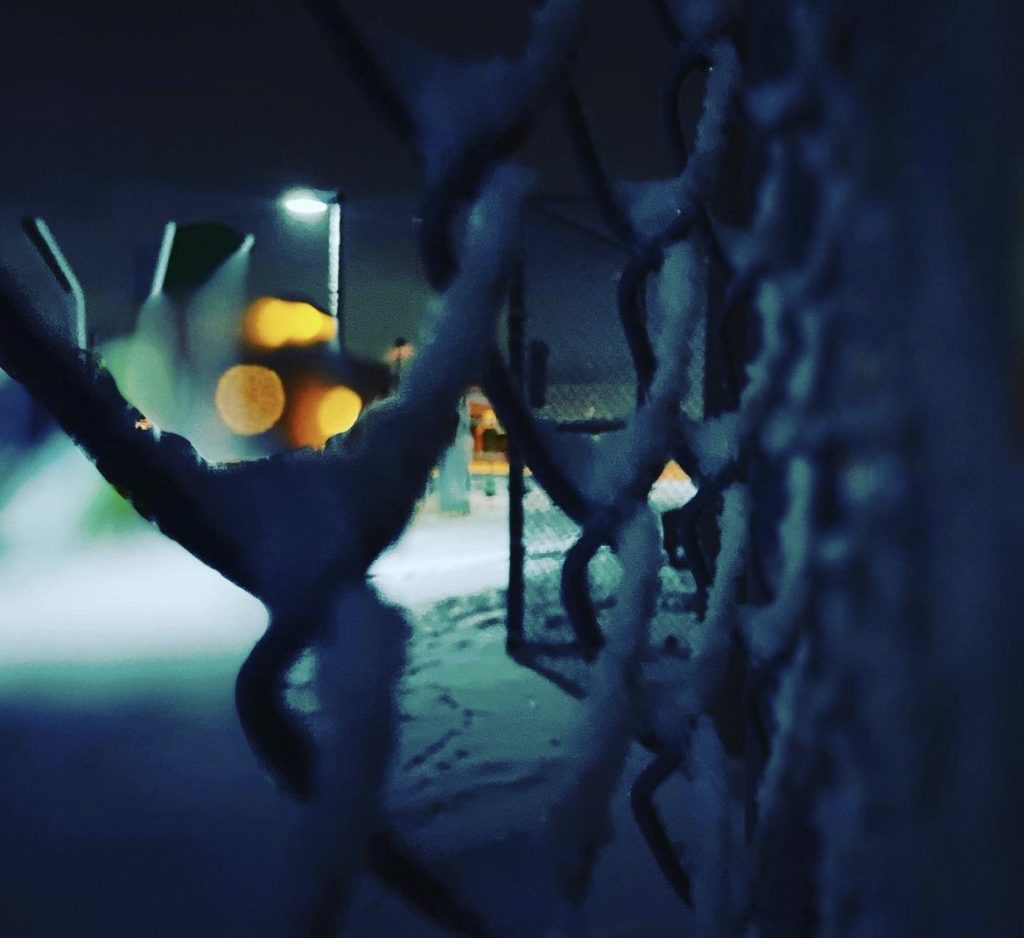
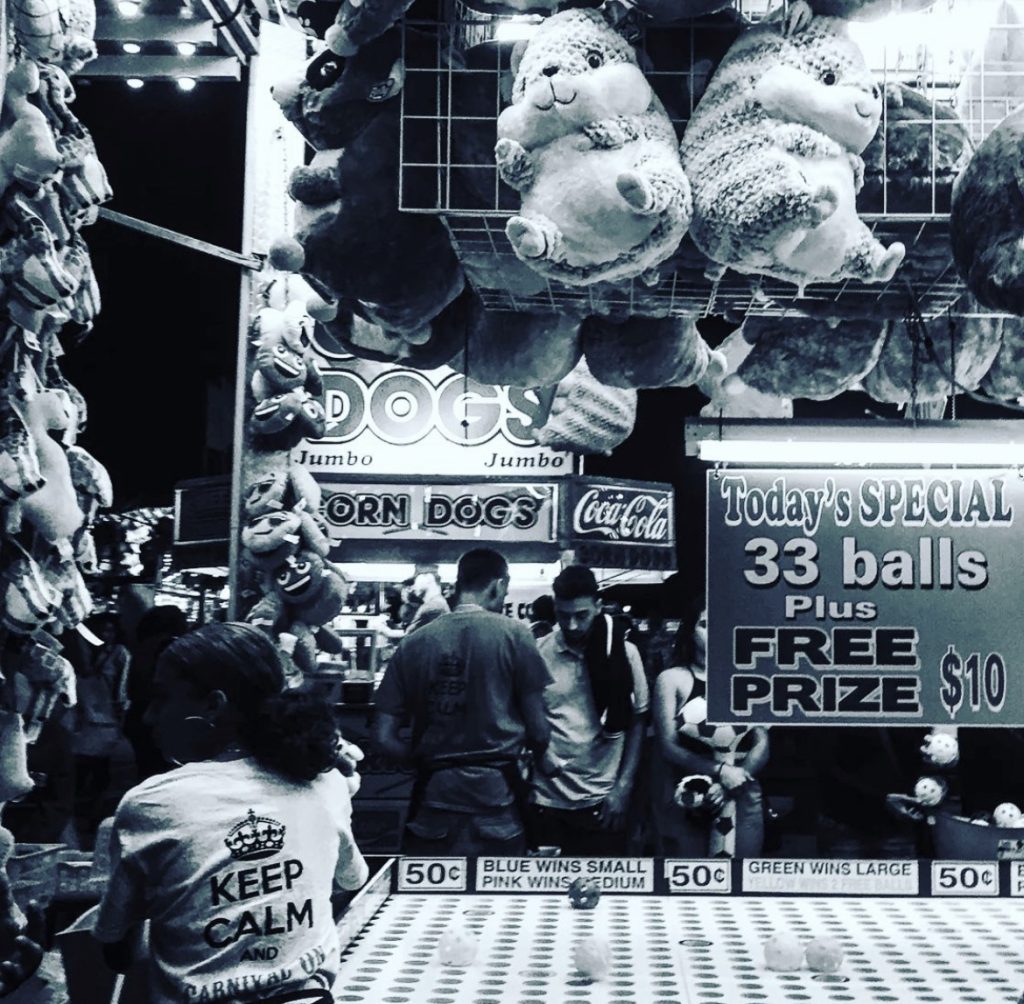

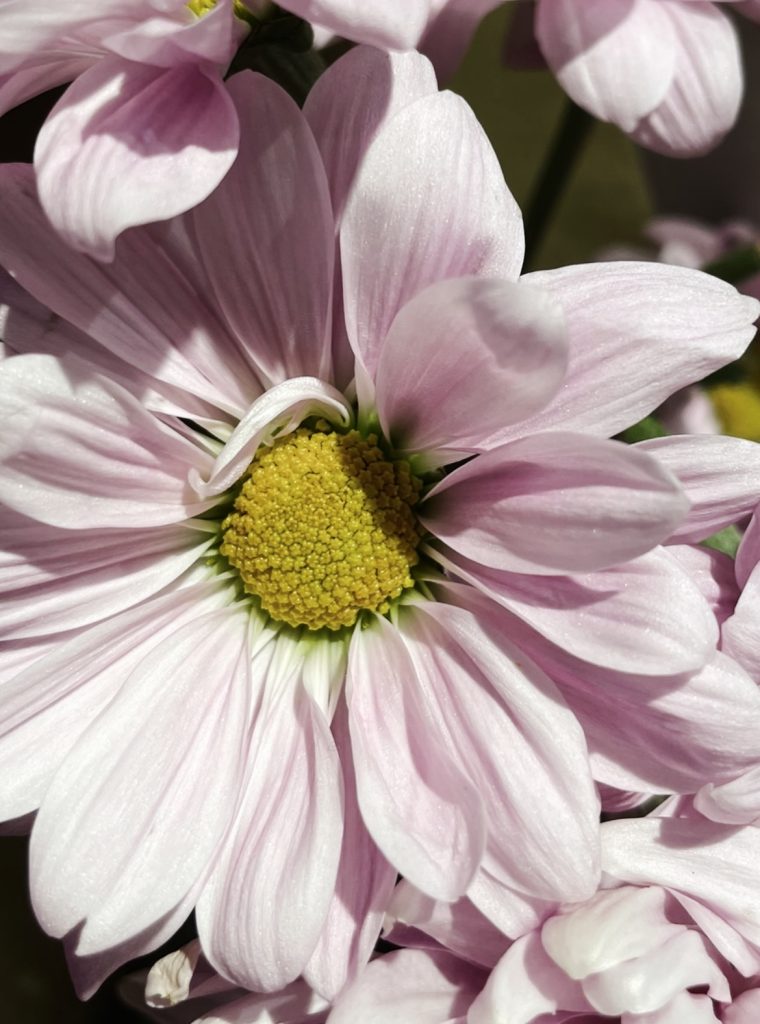
Brian Michael Barbeito is a Canadian writer and photographer. Recent work appears at The Notre Dame Review.
Spirit of a Place, Spirit of a Thing (Artist Statement)
In an off handed remark during an interview, U.G. Krishnamurti, called by some an anti-guru, and by himself, ‘Something like a philosopher,’ said that he once thought he could sense the spirit of a place. But then he brushed it off through words and body language. It didn’t fit in with his philosophy and message. But I resonated with his statement anyhow, because I had always felt that I could feel the spirit of a place and also a thing. Old town, lake still and wide. City street, carnival game vendor and prizes. Bee. Spider. Flower. Vine. Ridge. Summit. Stone. Petal. Stream. Sun. Cloud. Bird and dusk, horizon and dawn. Lock, denoting love, affixed to lonesome bridge alone in the rain. Artifacts. Areas. Some saturnine and some sanguine. Hundreds of places and things, their spirit, against reason and logic, somehow speaking out, not with language of course, but calling out nevertheless. Semantics and nomenclature could argue what spirit means. Is it the atmosphere, the daemon, the angel, the area, the vibration, the feeling? Is it physical, metaphysical, true and there, or purely imaginary and projected? Difficult to know conclusively. But there is something I think in all that mise- en-scene, and so on the rural footpaths and metropolitan worlds also, I try and photograph it and also write about it, this spirit of a place.
Song lyrics from Chimezie Ihekuna
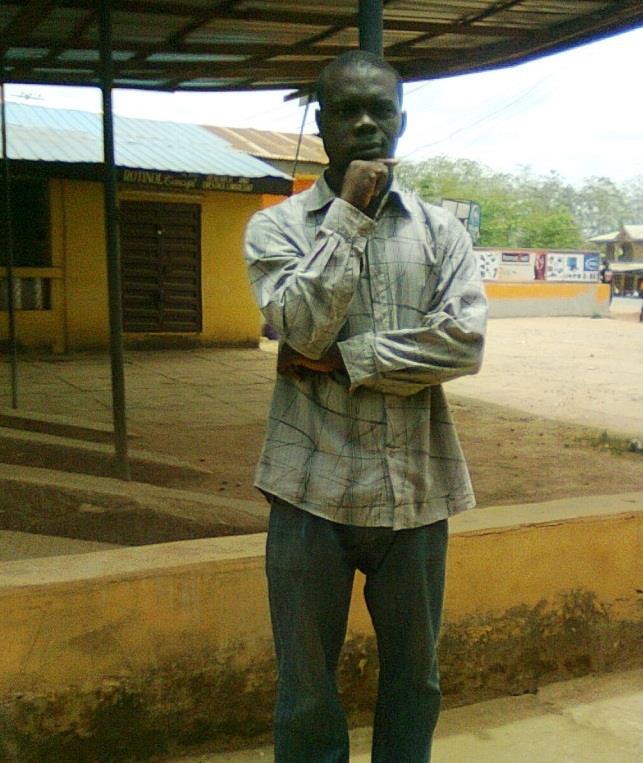
Title: Where am I headed Genre: Pop (Spoken word) Verse 1 I was lost in myself; I hardly could figure out why But when I tried asking ‘’why?’’ It became very blurry the answer Could it be what I thought I knew Or what is happening around me? I looked at the completeness of my world Only to realize how vague it has become My perception , I thought, would guide me But the contradiction, compared to what I’m encountering, is something else Am I just becoming ignorant or in a conundrum? Then, I’d say, ‘’time would tell’’ However, time, I realized, was my foe So, I have to really figure out where am I headed? Verse 2 Come to think of it, I was educated Educated?! Okay, I was taught in school what’s right from what’s wrong On second thought, recognizing the anomalies in my life and the world as a whole I’m observing that everything is so wrong that what’s left isn’t right! What I was taught was ‘’the good’’ seem to be the bad And vice-versa Can this really be? Hmmm…Trying to think through But wait, can provide an answer to what I don’t know? Well, perhaps, the wrong answer! To the issue at hand, did I learn the right thing? Can I change the situation around me? I believed in the world of possibility But my perception is fighting against what is around me! Oh yea! Something isn’t right So, It’s time I looked at the mirror and ask Where am I headed? Verse 3 Can anything worth learning ever be taught? A question I was forced to ask myself I have to re-evaluate what my thoughts are about everything A friend really challenged when she asked ‘’what if all you knew about everything and what you are being told and taught about everything were all false, what you goinna do?’’ Till this day, i have no concrete answer Yet, I’m poised to challenge myself and move in this light ‘’How?’’ I asked, looking to the heavens for answers After lengthy years of thinking and asking people questions, I came to the realization: Unlearn the inconsistent to relearn what ought to be ingrained in mindset of my formative years for a proper learning That, I knew, would help me change what I encountered ‘’Afterall, a change in my thought-process, better yet, my perception, would change my circumstances, my world, that is.’’, I thought. ‘’And make the world at large a better place’’ ‘’How do you want to go about it?’’ someone asked me, as I talked to him about my situation It’s going to be a long path to illumination Then, I would know where I am headed
